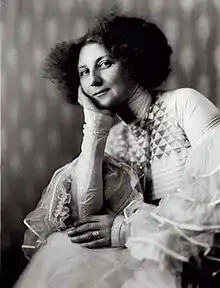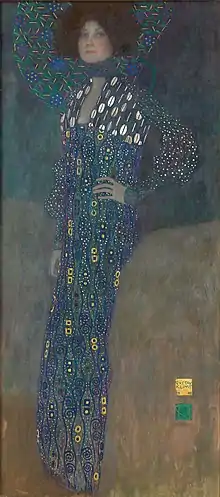Emilie Louise Flöge
Emilie Louise Flöge (30 August 1874 in Vienna – 26 May 1952 in Vienna) was an Austrian fashion designer, and businesswoman. She was the life companion of the painter Gustav Klimt.
Emilie Louise Flöge | |
|---|---|
 Emilie Louise Flöge, studio of Madame D'Ora-Benda, Vienna, 1909. | |
| Born | August 30, 1874 |
| Died | May 26, 1952 (aged 77) |
| Occupation | Couturière |
| Partner(s) | Gustav Klimt |
Early life

an oil painting by Gustav Klimt
Flöge was the fourth child of the master turner and manufacturer of Meerschaum pipes, Hermann Flöge (1837–1897). Emilie had two sisters, Pauline and Helene, and a brother, Hermann.[1]
Her first job was as a seamstress, but she later became a couturière. In 1894, Pauline, her elder sister, opened a dressmaking school[2] and Emilie worked here. In 1899 the two sisters won a dressmaking competition and were commissioned to make a batiste dress for an exhibition.
Career
In partnership with her sister Helene, after 1904 Flöge established herself as a successful businesswoman and the owner of the haute couture fashion salon known as Schwestern Flöge (Flöge Sisters) in a major Viennese thoroughfares, the Mariahilfer Strasse.[3] In this salon, which had been designed in the Jugendstil by the architect Josef Hoffmann, she presented designer clothing in the style of the Wiener Werkstätte. Flöge designed bespoke garments, especially loose, patterned dresses in the reform style. During her trips to London and Paris she familiarised herself with the latest fashion trends from Coco Chanel and Christian Dior, however, after the Anschluss with the German Third Reich in 1938, Flöge lost her most important customers and had to close her salon, which had become the leading fashion venue for Viennese society.[4] After 1938 she worked from the top floor of her home at 39 Ungargasse.[5]
Association with Gustav Klimt
Emilie Flöge was a member of the Viennese bohemian and Fin de siècle circles. She was the life companion of the painter Gustav Klimt.[6][7] In 1891, Helene, the older sister of Emilie, married Ernst Klimt, the brother of Gustav Klimt. When Ernst died in December 1892, Gustav was made Helene's guardian. At that time Emilie was eighteen years old and Gustav became a frequent guest at the home of her parents, spending the summers with the Flöge family at Lake Attersee.[1] Numerous photographs document Klimt with Emilie and her family.[8][9]

After 1891, Klimt portrayed her in many of his works. Experts[10] believe that his painting The Kiss (1907–08) shows the artist and Emilie Flöge as lovers.
Klimt also drew some garments for the Flöge salon in the rational dress style - a style promoted by the feminist movement - and from 1898, other clothes designed by the Vienna Secession; the latter were worn without a corset and hung loosely from the shoulders with comfortable, wide sleeves.[11] The clientele for what was at that time a revolutionary fashion was too small to provide a living, however, and she earned money accordingly through conventional styles. Klimt was painting many ladies from the upper echelons of Viennese society and thus was able to introduce Emilie Flöge to a prosperous client base.[12]
Klimt died from a stroke on 11 January 1918. His last words reportedly were, "Emilie must come."[13] She inherited half of Klimt's estate, the other half going to the painter's family.[1]
In the final days of the Second World War, her house in the Ungargasse caught fire, destroying not only her collection of garments, but also valuable objects from the estate of Gustav Klimt.[14]
Death and Burial
Flöge died at the age of 77 in Vienna during the afternoon of 26 May 1952 but after some years the grave was forfeited and its whereabouts were forgotten. It was eventually discovered that she had been buried in the family grave of the Flöge-Donner family at the Evangelischer Friedhof in Vienna-Simmering. The cemetery authorities designated it as a celebrity grave and restored the tombstone for the 150th Anniversary Year of Gustav Klimt. The grave is now included on their website.[15]
References and sources
- References
- "Schönheitsideale & Ornamentik - Damen der Gesellschaft". Museum online. 1996. Archived from the original on 2011-07-06. Retrieved 2011-02-25.
- Gustav Klimt, Emilie Flöge : reforming fashion, inspiring art. Tretter, Sandra; Weinhäupl, Peter, 1962-, Leitner, Martina. Vienna. ISBN 978-3-7106-0071-5. OCLC 962180850.CS1 maint: others (link)
- Gustav Klimt, Emilie Flöge : reforming fashion, inspiring art. Tretter, Sandra; Weinhäupl, Peter, 1962-, Leitner, Martina. Vienna. ISBN 978-3-7106-0071-5. OCLC 962180850.CS1 maint: others (link)
- Furman, Anna (2017-09-19). "Before Coco Chanel There Was Emilie Flöge: A Designer the Fashion Industry Forgot". Harper's BAZAAR. Retrieved 2020-03-09.
- Gustav Klimt, Emilie Flöge : reforming fashion, inspiring art. Tretter, Sandra; Weinhäupl, Peter, 1962-, Leitner, Martina. Vienna. ISBN 978-3-7106-0071-5. OCLC 962180850.CS1 maint: others (link)
- Fischer, Wolfgang Georg, 1933- (1992). Gustav Klimt & Emilie Flöge : an artist and his muse. McEwan, Dorothea. London: Lund Humphries. ISBN 0-85331-607-4. OCLC 24743238.CS1 maint: multiple names: authors list (link)
- Powell, Nicolas. "Emilie Floge and her lover Gustav Klimt." Apollo: The International Magazine for Collectors, August 1982, Vol. 116, p112-114.
- York, Neue Galerie New. "Neue Galerie New York". neuegalerie.org. Retrieved 2020-03-09.
- York, Neue Galerie New. "Neue Galerie New York". neuegalerie.org. Retrieved 2020-03-09.
- Alfred Weidinger (art historian and vice director of Belvedere Museum Vienna) in interview in ORF broadcast "Klimt am Attersee", 26 Aug 2012.
- York, Neue Galerie New. "Neue Galerie New York". neuegalerie.org. Retrieved 2020-03-09.
- Gustav Klimt, Emilie Flöge : reforming fashion, inspiring art. Tretter, Sandra; Weinhäupl, Peter, 1962-, Leitner, Martina. Vienna. ISBN 978-3-7106-0071-5. OCLC 962180850.CS1 maint: others (link)
- Powell, Nicolas. "Emilie Floge and her lover Gustav Klimt." Apollo: The International Magazine for Collectors, August 1982, Vol. 116, p112-114.
- Gustav Klimt, Emilie Flöge : reforming fashion, inspiring art. Tretter, Sandra; Weinhäupl, Peter, 1962-, Leitner, Martina. Vienna. ISBN 978-3-7106-0071-5. OCLC 962180850.CS1 maint: others (link)
- Gustav Klimt, Emilie Flöge : reforming fashion, inspiring art. Tretter, Sandra; Weinhäupl, Peter, 1962-, Leitner, Martina. Vienna. ISBN 978-3-7106-0071-5. OCLC 962180850.CS1 maint: others (link)
- Sources
- This article began as a translation of the article in the German Wikipedia at de: Emilie Flöge with additional information from the French Wikipedia at fr: Emilie Flöge.
Further reading
- Gustav Klimt, Emilie Flöge: Reforming Fashion, Inspiring Art, edited by Sandra Tretter and Peter Weinhäupl. Vienna: Gustav Klimt / Wien 1900 Foundation, 2016. ISBN 9783710600715.
- Gustav Klimt & Emilie Flöge: An Artist and His Muse, by Wolfgang Fischer with assistance from Dorothea McEwan. London: Lund Humphries, 2012. ISBN 0853316074.
- Gustav Klimt & Emilie Flöge: Photographs, edited by Agnes Husslein-Arco and Alfred Weidinger. Munich: Prestel, 2012. ISBN 9783791352473.
- O'Connor, Anne-Marie (2012). The Lady in Gold, The Extraordinary Tale of Gustav Klimt's Masterpiece, Portrait of Adele Bloch-Bauer, Alfred A. Knopf, New York, ISBN 0-307-26564-1
External links
- Emilie Louise Flöge in Austria-Forum (in German) (at AEIOU)
- Literature by and about Emilie Louise Flöge in the German National Library catalogue
- Additional images at https://web.archive.org/web/20171110061930/http://www.klimt.com/en/gallery/photographies/details-emilie-floege.dhtml"Klimt Museum" commercial website